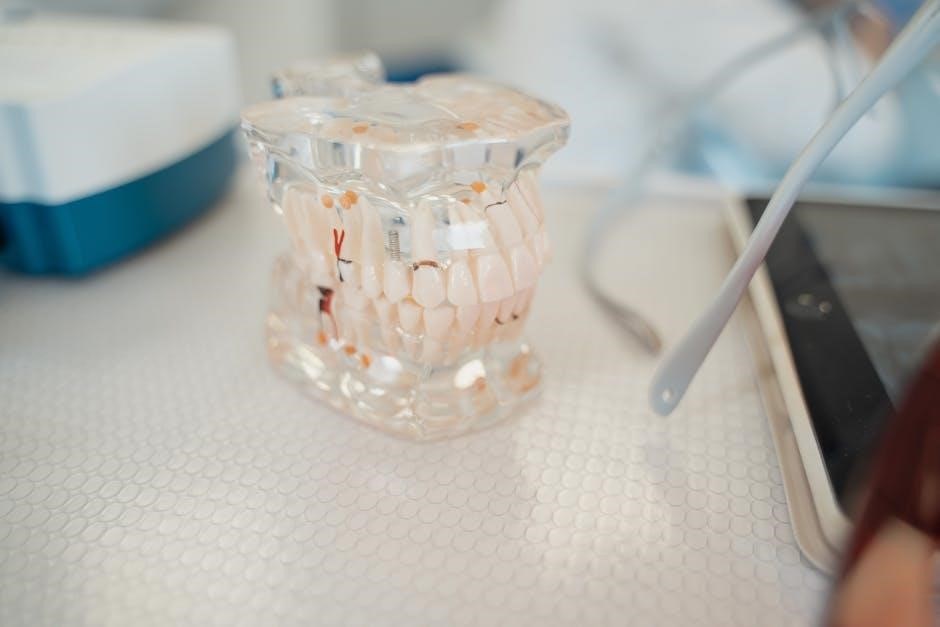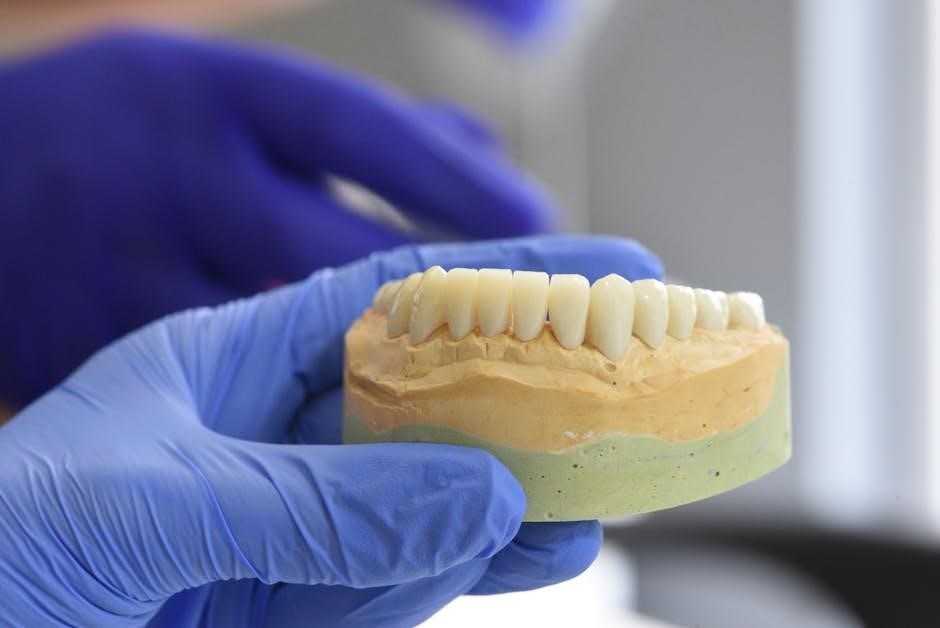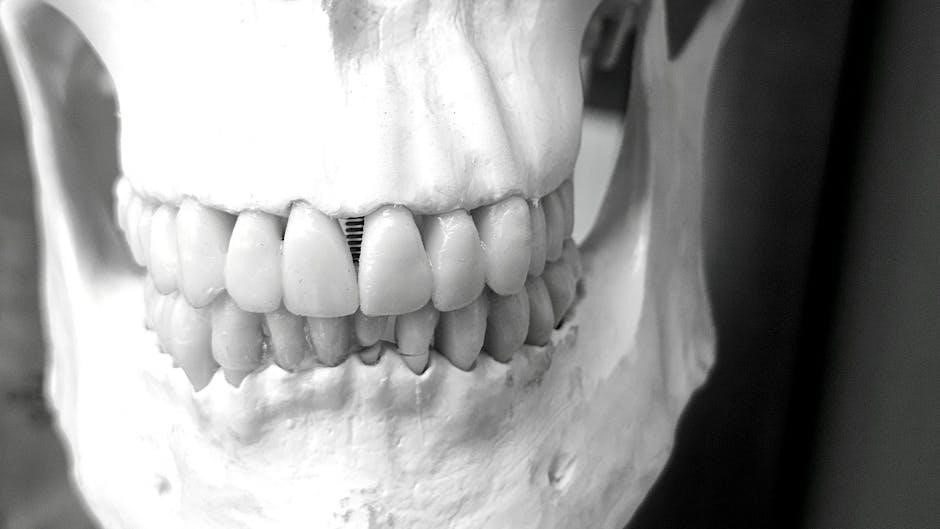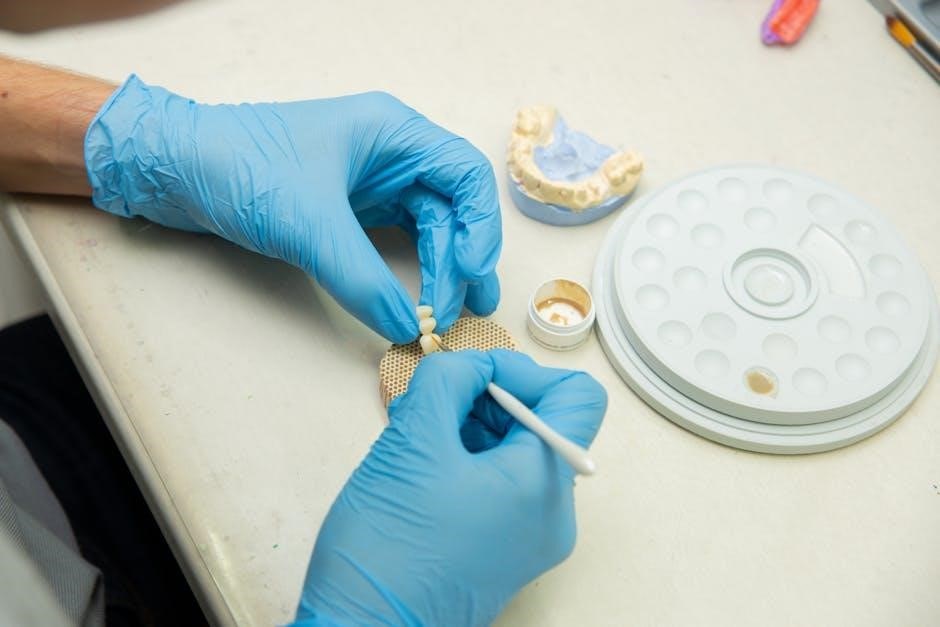Immediate Post-Surgery Care
Swelling peaks 2-3 days post-surgery and subsides within a week. Use ice packs to reduce swelling. Avoid disturbing the wound or rinsing vigorously for 24 hours. Keep the area clean with gentle mouthwashes as directed. Rest and limit physical activity for the first 3-4 days to promote healing. Bleeding is normal but should be minimal; monitor and apply gauze if needed. Avoid smoking and alcohol for 48 hours to prevent complications and ensure proper blood clot formation.
Bleeding and Swelling
Bleeding after dental implant surgery is typically minimal but expected. Gently biting on gauze for 30-45 minutes can help control it. Swelling is most pronounced 2-3 days post-surgery and subsides within a week. Applying ice packs to the affected area during the first 24 hours can reduce swelling. Avoid vigorous rinsing or spitting, as this may dislodge the blood clot. Monitor bleeding and contact your surgeon if it persists or worsens. Keep your head elevated while resting to minimize swelling and promote healing.
Initial Hygiene Practices
Keep the surgical area clean to prevent infection. Start with saltwater rinses 24 hours post-surgery, continuing for 7-10 days. Use prescribed antibacterial mouthwash twice daily. Avoid using straws or spitting forcefully, as this can dislodge the blood clot. Gently brush teeth with a soft-bristle toothbrush, avoiding the implant site. Maintain overall oral hygiene by cleaning adjacent teeth and gums thoroughly. Avoid touching or disturbing the surgical site with fingers or tongue to ensure proper healing and minimize the risk of complications;

Dietary Recommendations
A liquid or soft diet is essential for the first 24 hours. Progress to soft foods for a week, then gradually introduce nutrient-rich foods to support healing. Avoid hard or chewy items initially to protect the implant site and ensure proper recovery. Opt for mild, non-irritating foods to minimize discomfort and promote a smooth recovery process.
First 24 Hours: Liquid or Soft Diet
Stick to a liquid or soft diet for the first 24 hours after surgery. Choose gentle options like soups, yogurt, or smoothies to minimize discomfort. Avoid chewing near the surgical site to protect it from irritation. Opt for mild, non-irritating foods that require minimal effort to eat. This approach helps reduce swelling, promotes healing, and prevents dislodging the blood clot. Avoid hot foods, alcohol, and drinking through straws during this period to ensure proper recovery and minimize risks of complications.
First Week: Soft Foods Only
For the first week after surgery, stick to soft foods like mashed potatoes, scrambled eggs, and soft-cooked vegetables. Avoid hard, crunchy, or chewy foods that could irritate the surgical site. Use a spoon to minimize mouth movement and chew gently on the opposite side of your mouth. Opt for foods rich in nutrients to support healing, but keep them soft and easy to eat. This approach reduces discomfort and protects the implant site during the initial healing phase.
Extended Period: Nutrient-Rich Diet
After the first week, gradually introduce nutrient-rich foods to support healing and overall health. Focus on soft, balanced meals like lean proteins, calcium-rich foods, and vitamins. Avoid hard or crunchy foods for several weeks. Incorporate foods like steamed vegetables, fish, and whole grains while maintaining a soft consistency. A nutritious diet promotes bone healing and implant integration. Continue to avoid chewing directly on the implant site until fully healed, as advised by your surgeon.

Oral Hygiene Routine
Rinse with saltwater or prescribed mouthwash to keep the area clean. Gently brush the surrounding teeth with a soft toothbrush, avoiding the surgical site for the first week.
Rinsing with Saltwater or Mouthwash
Rinsing with warm saltwater or antibacterial mouthwash is essential after dental implant surgery. Start 24 hours post-surgery, rinse twice daily to prevent infection. Saltwater helps reduce swelling and promotes healing. Avoid vigorous rinsing to protect the blood clot. Continue this routine for 7-10 days or as directed by your surgeon. This practice ensures the surgical site remains clean and fosters a conducive environment for proper recovery and implant integration.
Brushing Techniques and Timing
Begin gentle brushing 24 hours after surgery, using a soft-bristled toothbrush. Avoid direct contact with the implant site for the first week. Gently clean surrounding teeth and gums to maintain oral hygiene. Gradually resume normal brushing after the initial healing phase, ensuring not to apply pressure on the implant area. This careful approach prevents irritation and supports proper healing, allowing the implant to integrate successfully with the surrounding bone and tissue over time.
Pain and Discomfort Management

Take prescribed pain medication as directed to manage discomfort. Use ice packs to reduce swelling and ease pain. Follow your surgeon’s guidelines for medication and recovery.
Medication Guidelines
Take prescribed pain medication as directed to manage discomfort. Avoid exceeding recommended doses. Antibiotics may be prescribed to prevent infection. Follow the prescribed schedule and complete the full course. Use ice packs to reduce swelling and ease pain. Inform your surgeon if experiencing severe pain or side effects. Adhere to medication guidelines to ensure proper healing and minimize complications.
General Tips for Pain Relief
Rest and relax to reduce discomfort. Apply ice packs to the surgical area to minimize swelling and ease pain. Stay upright to reduce pressure on the implant site. Eat soft, cool foods to avoid irritating the area. Gently rinse with saltwater or prescribed mouthwash to keep the site clean. Avoid smoking or alcohol, as they can hinder healing and increase pain. Monitor your condition and contact your surgeon if pain persists or worsens unexpectedly.
Swelling and Bruising
Swelling peaks 2-3 days post-surgery and subsides within a week. Bruising may appear and fade gradually. Use ice packs to reduce swelling and promote healing.
Timeline and Expectations
Swelling typically peaks within 2-3 days after surgery and gradually subsides over the next week. Bruising may appear and fade within 7-10 days. The healing process around the implant site continues for several months, with full integration taking up to 3-6 months. Patients should expect some discomfort during this period, but it should diminish as healing progresses. Monitoring the surgical site for any unusual changes is crucial during the initial recovery phase.
Remedies to Reduce Swelling
To manage swelling after dental implant surgery, apply ice packs to the affected area for 15-20 minutes at a time during the first 24-48 hours. Keep your head elevated while resting to reduce fluid accumulation. Gentle facial exercises can also help alleviate swelling. Avoid smoking and alcohol, as they impede healing and may worsen inflammation. Stay hydrated and maintain a soft, balanced diet to support recovery. These measures can significantly minimize swelling and promote a smoother healing process.
Physical Activity Levels
Rest is crucial for the first 3-4 days post-surgery. Avoid strenuous activities to prevent dislodging the implant. Resume normal activities gradually, ensuring healing progresses without complications.
Rest and Relaxation Guidelines
Rest is essential immediately after surgery to promote healing. Elevate your head slightly while resting to reduce swelling. Avoid strenuous activities or bending for 3-4 days. Use ice packs on the surgical area to minimize swelling and discomfort. Limit physical exertion to prevent dislodging the implant. Gentle movements are okay, but avoid heavy lifting or exercise. Resume normal activities gradually, ensuring the healing process is not disrupted. Adequate rest supports optimal recovery and implant integration.
Resuming Normal Activities
Most patients can gradually resume normal activities 4-5 days after surgery. Avoid heavy lifting or strenuous exercise for 1-2 weeks. High-impact sports or activities that risk injury to the mouth should be avoided for up to 6 months. Listen to your body and balance activity with rest to support healing. Light exercises, such as walking, can usually be restarted after 48 hours. Always follow your surgeon’s specific advice to ensure proper recovery and implant integration.
Smoking and Alcohol Consumption
Smoking should be avoided for at least 10 days post-surgery to prevent healing disruptions. Alcohol consumption is restricted for 48 hours to maintain blood clot integrity and promote recovery.
Risks of Smoking After Surgery
Smoking after dental implant surgery significantly increases the risk of complications, including implant failure. Nicotine impairs blood flow, delaying healing and weakening the bone-implant bond. Smoking can also lead to dry socket, a painful condition, and may cause infections. Additionally, smoking prolongs recovery time and reduces the overall success rate of the implant. It is strongly advised to avoid smoking for at least 10 days post-surgery to ensure proper healing and osseointegration.
Alcohol Consumption Restrictions
Alcohol consumption should be avoided for at least 48 hours after dental implant surgery. Alcohol can interfere with blood clot formation, increasing the risk of bleeding and delaying healing. It can also impair the body’s ability to fight infection and reduce the effectiveness of pain medications. Excessive alcohol use may weaken the bone-implant bond, leading to implant failure. Patients are advised to abstain from alcohol during the initial recovery period to ensure proper healing and minimize complications. Always follow your surgeon’s specific guidance.

Follow-Up Appointments
Schedule a follow-up appointment within 4-6 months for Stage 2 surgery to expose the implant. Regular check-ups ensure proper healing and integration of the implant.
Timing and Importance
Follow-up appointments are crucial for monitoring healing and ensuring proper implant integration. Schedule the first post-operative visit within 1-2 weeks to assess recovery and address concerns. Subsequent appointments are typically spaced at 4-6 weeks to monitor progress. A second minor surgery, Stage 2, is usually planned 4-6 months after the initial procedure to expose the implant. Regular check-ups ensure long-term success, prevent complications, and confirm the implant’s proper functioning and stability, which is vital for both aesthetics and oral health.
Stage 2 Surgery Overview
Stage 2 surgery typically occurs 4-6 months after the initial implant placement. This minor procedure exposes the implant head, allowing for the attachment of a healing abutment or temporary crown. The process is straightforward, often requiring only local anesthesia. Recovery is usually quick, with mild swelling or discomfort. Proper care post-Stage 2 ensures the implant remains stable and ready for the final restoration, such as a permanent crown or denture, completing the dental implant process for functional and aesthetic results. Patience during this phase is key for optimal outcomes.
Recognizing Complications
Monitor for signs of infection, such as increased redness, swelling, or pus. Implant failure may occur if the implant feels loose or shifts. Contact your surgeon immediately if unusual symptoms persist or worsen.
Signs of Infection or Failure
Watch for redness, swelling, or pus around the implant site, which may indicate infection. Persistent pain, a bad taste, or loosening of the implant are concerning signs. If the implant feels unstable or shifts, it may signal failure. Contact your surgeon immediately if you experience these symptoms, as prompt treatment is crucial to address complications and ensure proper healing. Early intervention can prevent further issues and safeguard the success of your dental implant procedure.
When to Contact Your Surgeon
Contact your surgeon if you experience excessive bleeding, severe pain, or swelling that worsens. If you develop a fever, notice redness or pus around the implant, or feel the implant shifting, seek immediate care. Persistent bad taste, numbness, or tingling in the mouth are also concerning signs. If your symptoms do not improve or worsen despite following post-op instructions, reach out to your surgeon promptly to address potential complications and ensure proper healing.